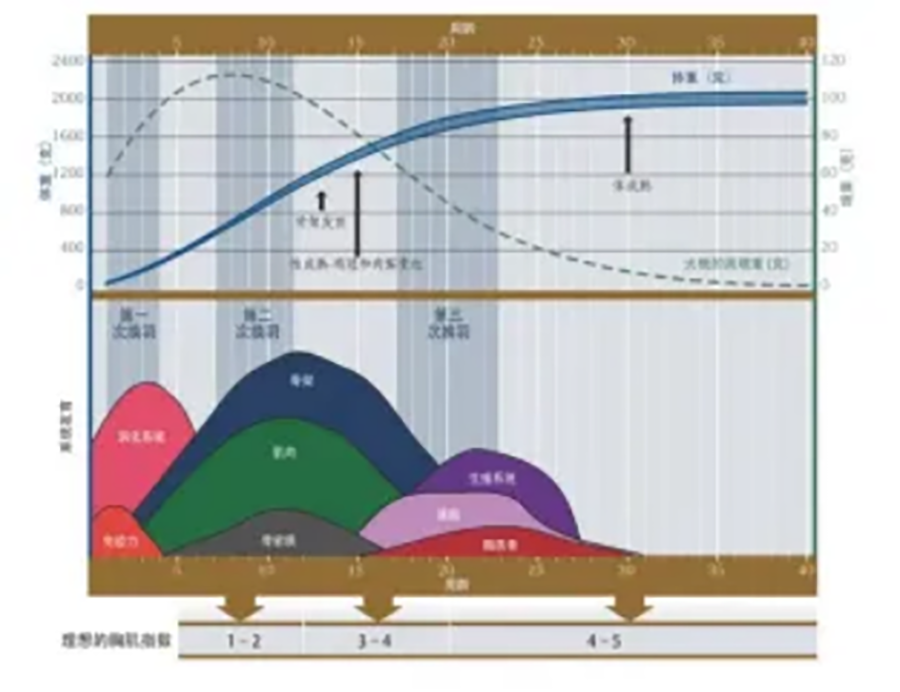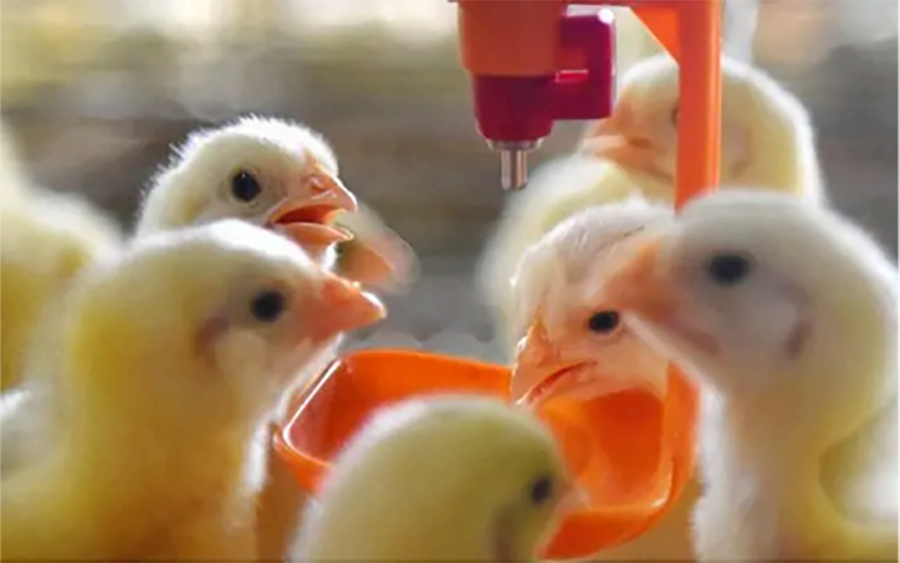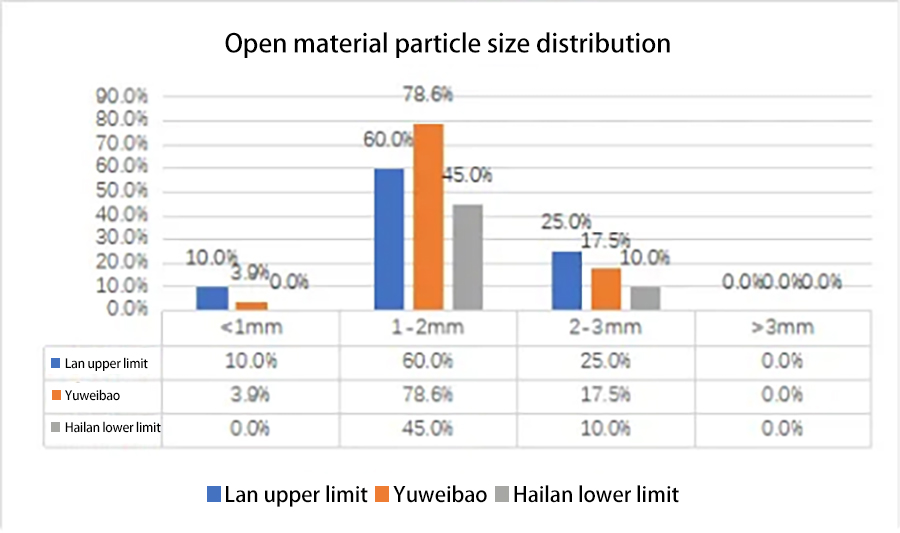Copyright © Shandong Wedo Agritech Co., Ltd. All Rights Reserved. Site Map
- +86-15253660961
- service@wedoagritech.com
- 67-2, Headquarters Base, Beihai Road, Weifang, Shandong

The significance of tapping the potential of laying hens during their opening period

(Note: The picture comes from the Hy-Line breeding and management manual)
The opening period of laying hens generally refers to 0-3 weeks of age. During this stage, the digestive system and immune system of the chicks develop rapidly, especially the glandular stomach and intestines in the digestive system. The total length of the digestive tract of adult laying hens is about 210cm, and the total length of the digestive tract at 21 days of age is about 95cm, accounting for about 45% of the digestive tract of adult chickens. The digestive organs of newborn chicks develop rapidly, and the relative weight of each organ reaches its peak at 4-5 days of age for the gizzard, 9 days for the pancreas, and 7 days for the small intestine. As we all know, the intestine is the main digestive and absorptive organ of laying hens, and it is also the largest immune organ of laying hens. The development potential can be maximized during the rapid development stage of the digestive tract, and the chickens will have solid nutrition intake and health protection during the growth and production stages.
Physiological characteristics of egg-laying chicks during the opening period

1. Imperfect body temperature regulation function
The body temperature of newborn chicks is 2℃-3℃ lower than that of adult chickens. It starts to rise after 4 days of age and approaches the body temperature of adult chickens at 10 days of age. The body temperature regulation function gradually develops and improves at 35 days of age, and the body temperature can be kept constant. The lower limit of lethal body temperature of 1-day-old chicks is 15℃. The younger the age, the stronger the tolerance to low body temperature. If the temperature drops gradually, even an environment of 25℃ can cause the death of chicks. Suitable environmental temperature is the key to the success of brooding. Especially for weak chicks, it is more beneficial to appropriately increase the brooding temperature.
2. The digestive organs are small and develop quickly
Newborn chicks have a small digestive tract capacity (especially the stomach), weak muscular grinding power, weak digestive enzyme secretion ability, and insufficient digestive power. However, the digestive organs of newborn chicks develop quickly. If chickens are fed with finely ground feed that lacks crude fiber and sand from a young age, their gizzards will have small amplitude, weak contraction, poor development, small volume, and small gizzard cavity capacity, which will cause feed to remain in the glandular stomach, leading to glandular stomach expansion. If chickens accidentally ingest a large amount of crude fiber or sand, it may also lead to gizzard obstruction. Therefore, chick feed should contain a certain amount of crude fiber, but not too much.
3. Incomplete development of the enzyme system
Newborn chicks secrete less intestinal amylase, pancreatic protease, pancreatic lipase and chymosin. After 5 days of age, intestinal amylase and pancreatic protease can reach higher levels. Chickens have no cellulase in their digestive tract, so chicks cannot digest and utilize cellulose.

4. The structure of the digestive tract flora has not yet been finalized
The number of microorganisms in certain areas of the poultry intestine can exceed 100 billion per gram of feces. There are two main types of flora: one is acidophilic lactobacillus, and the other is the flora free in the intestinal cavity. For example, lactobacillus becomes the dominant flora in the chicken digestive tract, and some pathogens are difficult to colonize and proliferate in the digestive tract. It is strictly forbidden to abuse antibiotics. The use of microbial preparations to maintain the normal flora structure of the digestive tract of chicks is conducive to the normal growth and development of chicks.
5. Underdeveloped immune system
The immune organs of newborn chicks are immature. The immune response matures after 10 weeks of age, and vaccination can produce a good immune effect. The first immunization of Newcastle disease is to mobilize the formation of antibodies. The purpose of the first immunization is to allow more immune cells to participate in basic immunity. The hamstrings behind the eyes of chicks concentrate many immune cells, so the first immunization should be done by eye drops. The effectiveness of the first vaccination against Newcastle disease in chickens is four times higher when administered by eye drops than by drinking water.
6. Timid, afraid of shock, strong stress response
The carbohydrate content in eggs is very low, and most of it is consumed during the incubation process, so the glycogen reserves in newborn chicks are very small. Under stress, the gluconeogenesis of chicks increases, converting amino acids into glycogen. Therefore, feeding high-carbohydrate feed or adding glucose to newborn chicks can increase the blood sugar and liver glycogen concentration of chicks, increase glycogen reserves, and thus improve the survival rate of chicks. Under stress, the secretion of catechol and adrenal cortex hormones in chickens increases, and vitamin C is an essential cofactor for the synthesis of the two. Under stress, the amount of vitamin C in the intestines, liver and white blood cells of chicks decreases, causing the immune response of chicks to decrease. Under normal circumstances, poultry can synthesize vitamin C to meet their needs. Chicks under two weeks of age cannot synthesize vitamin C and can only be supplemented through feed or drinking water. Stress in newborn chicks can cause the blood vessels around the ovum bundle to contract, and the chicks cannot fully utilize and absorb ovum nutrients and ovum antibodies. Therefore, maintaining a stable environment and preventing the stimulation of various stress factors are of special significance in the feeding and management of newborn chicks.
7. Yolk sac
When the chicks hatch, the ovarian sac moves from the egg cavity into the embryo's abdominal cavity. One end of the ovarian sac is connected to the navel through the vascular bundle. It gradually shrinks after hatching and separates from the navel at 3-5 days of age. The other end opens into the jejunum through the ovarian tube. When hatching, the ovum weighs about 6.8 grams and the dry weight is 4.1 grams, accounting for about 13%-14% of the body weight. The ovum is basically absorbed 4-5 days after hatching, and the ovum sac contains rich nutrients. There is residual unabsorbed egg yolk in the abdomen of newborn chicks. The nutrients needed by the chicks within 3-5 days after hatching mainly come from the residual egg yolk. If the chicks' abdomens are kept at a suitable temperature and they drink enough water, it will help the absorption of the residual egg yolk, strengthen the chicks' physique, and improve their survival rate.
8. Yolk Antibody
There are about 200 mg IgG in the body of a newborn chick, almost all of which comes from the mother. There is residual immunoglobulin IgG in the egg yolk of the newly hatched chick. These immunoglobulins flow into or are secreted into the blood and then distributed to the various organs and tissues of the chicken. At 7 days of age, this part of IgG is gradually replaced by IgA produced by the chick itself, and the chick gradually builds up its own immunity.
Summary and recommendations
Compared with other livestock and poultry, newborn chicks have unique anatomical and physiological characteristics. According to these characteristics, selecting high-quality open feed and taking corresponding feeding management and disease prevention and control measures are of special significance to the growth and development and potential development of chicks.
Professional egg chick opening material design concept
The multi-dimensional integration of the physiological characteristics and nutritional requirements of laying hens:
Feed type: crushed feed, uniform particle size, appropriate hardness, low powder content.
Raw material application: select safe, highly digestible, easily absorbable high-quality raw materials.
Technology: reasonable crushing particle size, granulation temperature above 85℃.
Nutrition: high energy, high AA, vitamins, trace elements, meet the nutritional needs of laying hens.
Functional addition: Add enzyme preparations, acidifiers, microorganisms, plant extracts, etc. to improve quality and efficiency.
Features
Comprehensive nutrition: high energy, high protein and high amino acid design, can utilize the high nutrition deposited by growth.
Intestinal health: high-efficiency enzyme preparations, acidifiers, and microecological technology applications promote intestinal health and reduce inflammation.
High-quality raw materials: highly digestible and low-antigen raw materials, Northeast first-class corn, imported fish meal, puffed soybeans, fermented soybean meal, 85C high temperature ripening and sterilization, melt in the mouth, easier to digest and absorb.
Vitality and health: adding plant extracts to promote yolk absorption, relieve yolk nutrition transition stress, reduce the immune window period, and ensure survival rate.
Opening material particle size distribution


Dimension Brooding Agent allows chickens to surpass others at the starting line!